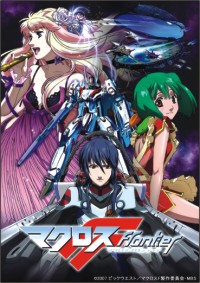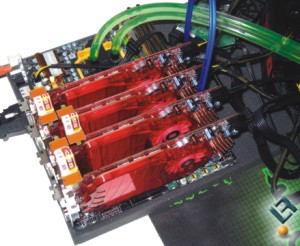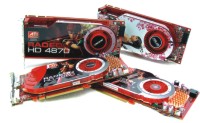Anime Review


by Le Chupacabra
Action/Drama
25 Episodes
Satelight
Ages 14+
The Macross Frontier has thus far succeeded in its mission to explore the outer reaches of space and is en route to finding an inhabitable world for its residents. The virulent, insect-like Vajra seem to disagree with these intentions and are hell-bent on destroying this colony of humans and Zentraedi who have since found peace with one another. Will another bloody battle ensue?
If Macross Frontier were but a music compilation, I'd be gushing incessantly right now. Heart-pounding drum and bass, melancholic string instrumentations and mercilessly catchy pop songs make this an intense, if not wholly original, soundscape. And guess what? No surprises here because the composer is one we all know and love: Yoko Kanno.
But that won't do, will it?
Built up around the music there are images and words, a story even. And this is where Macross Frontier starts to reduce that initial wide-eyed enthusiasm into something resembling disappointed indifference. See, you really want to love this show - nostalgia notwithstanding - but it does such a fine job of sapping its own strengths that all you feel near the end is pity. That's not what should be going through your mind after a supposedly epic space opera.
 The series goes through such a bevy of highs and lows that its almost menopausal. It starts off well enough: creating a believable world, thrusting you straight into some lovely, lovely Veritech fighter action. And they even succeed at introducing an androgynous male lead whose looks are incorporated quite well in the banter and humour. The innocent and charming Ranka makes her appearance, bumping into our hero Alto, setting up what is obviously going to turn into some messy love triangle later on. No, that is not a spoiler. This is Macross. Get over it. Soon enough, the third vertex comes into existence in the form of Frontier's own Minmay, Sheryl Nome.
The series goes through such a bevy of highs and lows that its almost menopausal. It starts off well enough: creating a believable world, thrusting you straight into some lovely, lovely Veritech fighter action. And they even succeed at introducing an androgynous male lead whose looks are incorporated quite well in the banter and humour. The innocent and charming Ranka makes her appearance, bumping into our hero Alto, setting up what is obviously going to turn into some messy love triangle later on. No, that is not a spoiler. This is Macross. Get over it. Soon enough, the third vertex comes into existence in the form of Frontier's own Minmay, Sheryl Nome.
One thing that I must extol is how strong and personable the female leads are, both of them different and utterly convincing in their roles. They develop rather naturally, with Ranka having to play plenty of catch-up to Sheryl, who's intensely talented and confidently knows it. Additionally, the show does such an annoyingly good job of swaying this way and that, you'll end up watching till the end to find out which one gets Alto.
 Therefore, it's a pity that things start devolving past the midpoint. You'll forgive her a bunch of times earlier on, but Ranka eventually never grows out of being a damsel-in-distress and regardless of everything happening around him, Alto himself remains completely apathetic. A hackneyed backstory of his past career as a Kabuki actor and his random battlecries are all that flesh him out as a individual. Like him, the remaining characters seem to carry inscrutable, baseless convictions that do them no favours whatsoever when it comes to the series asking you to care about them. Only a few members of the supporting cast shine, though all too briefly.
Therefore, it's a pity that things start devolving past the midpoint. You'll forgive her a bunch of times earlier on, but Ranka eventually never grows out of being a damsel-in-distress and regardless of everything happening around him, Alto himself remains completely apathetic. A hackneyed backstory of his past career as a Kabuki actor and his random battlecries are all that flesh him out as a individual. Like him, the remaining characters seem to carry inscrutable, baseless convictions that do them no favours whatsoever when it comes to the series asking you to care about them. Only a few members of the supporting cast shine, though all too briefly.
Since you can witness this degeneration, the intense battle scenes seem to feel increasingly vapid as the series nears its conclusion. My personal distaste of CGI also stopped me from fully enjoying the action because it came across as quite jarring. The Veritech fighters and the Vajra are rendered in 3D and this, in my humble opinion, detracts immensely from the viewing experience. It's a shame because there are moments when the camera pulls back and the entirety of the battlefield makes you simply hold your breath and then there are the smaller scenes back on the Frontier which delight you with wonderful plays of colour and lighting.
Ever so occasionally, Frontier evokes a quality that fully justifies the Macross moniker. Yet what becomes obvious is that unlike its forebears, it lacks an ambition to maintain a cohesive nature throughout. What you're left with is something that looks and sounds fantastic, but does little to hide a lacklustre plot and an imbalanced character cast. If you love Macross then give yourself and Frontier a chance but keep that copy of Plus handy. You may need to reassure yourself that the Skull Squadron haven't completely gone down in flames.


Let's get a few things out of the way first. A few basics and some informative what-nots. (I'll be using metaphors to avoid technical nerdy mumbo-jumbo.)
What exactly is a video, or rather a graphics card?
A graphics card is a computer peripheral, a hardware that is used to render images onto a display; that is, on a monitor.
What makes up a graphics card?
Several things.
VRAM: The amount of memory, or RAM, that your graphics card has. This, although very important, is heavily misunderstood in our culture. Everyone simply assumes that higher the memory, the better the card. Typically right. Generally wrong. I'll get back to that later.
Processor: A graphics-processing unit. A processor, kind of like the CPU, except it's dedicated for visual processing. Does most of the grunt work. Quite important.
Shaders: Um. Here's where I get into metaphors.
Everything in your monitor is made up tiny dots called pixels. Common resolutions include 1024 by 768 pixels. Or 1440 by 900 pixels. 786432 and 1296000 pixels respectively.
Now. Think of your graphics card as an art-studio. Instructions are sent in, and from there the card draws, renders and sends the image to the monitor. When you're in desktop, it doesn't take a lot of juice, as it's a 2D image with little to no advanced graphical work involved, such as lighting, shadows, detailed textures, etc. A 3D game on the other hand is a different matter.
 To get an enjoyable lag-free experience while gaming, your computer needs to render around 50 frames per second. That's 50 images consisting of millions of pixels every second. A card has to be able to take the load of that much work.
To get an enjoyable lag-free experience while gaming, your computer needs to render around 50 frames per second. That's 50 images consisting of millions of pixels every second. A card has to be able to take the load of that much work.
Imagine an artist and a painting. The more detail the artist needs to draw, the more effort it'll take him. And more so if the image was bigger. Now, imagine two painters working on the same painting. Naturally, it'll take less time. And what if the painters are faster and more efficient? It'll take even less time, and less effort to finish the drawing.
Shaders are kind of like painters, see? There used to different sets of shaders. One set for drawing shapes, another for filling in textures, etc. Now, there's just one set- Unified Shaders. There's also a clock-speed for these. The higher the clock-speed, the faster your card will be able to work those shaders. Games like Oblivion and Crysis has intensive shader-works involved.
The VRAM is quite simply like a storage system. It's used to store images already rendered. So, if all the OTHER specifications are low, and your card can't render enough, a high RAM is utterly useless.
Then there's the memory bus width rate, calculated in bits. The nVidia 8800GS for example has a 192 bit rate, while the 8800GTX has 384. Pushing water out of a wider pipe will obviously take less than through a thin pipe. All these things ultimately yield a maximum theoretical bandwidth. The higher the bandwidth, the more juice your card can pump.
When you're going to the market to buy a card, don't just ask for a 512MB video card. There used to be those several years back too, and they're all obsolete now. Research on the internet about what card you can get that's within in your budget. Look out for the bus width, the shaders, the clock-speeds, and the amount of VRAM. Check out reviews on websites like www.techpowerup.com, www.anandtech.com and www.tomshardware.com.
An nVidia 8800 model is waaay better than a 9400 model. A higher model number does not mean better. A wise choice can last you two to three years or more. Wasting your money on SLI and Crossfire, when you can do with a very good and cheap mid-range card is very silly.
Right now, ATI is leading the mainstream market thanks to its amazingly powerful and relatively cheap 4000 HD series cards. The high-end Radeon 4850 stands at the $150 range, while the GeForce GTX 260 is more than $250, for proportionally less juice. The saved $100 dollars can be used to buy a better processor or more RAM. You can never have enough RAM.
You must also remember that a high-end card means an increased power consumption, which means investing in a better power supply. A bad PSU can be as deadly spilling coke on your motherboard.
Bottom line? Research, research, research. Unless you're like… a loaded millionaire, in which case you can simply just dish out whatever you've got in your pockets for a quad-SLI on an Intel x58 motherboard with a core 2 extreme processor, feeding a circle of corporate businesses that thrive on upper crusts of the pie, whose sole motivation is their profit margins, using unseemly means like warehousing rival companies' products, buying out branded desktop/laptop manufacturers and crippling graphics drivers for god knows what reasons. I'm looking at you Intel and nVidia.
Fight the power!
By Emil
(ssemil@gmail.com)


By Sabhanaz Rashid Diya
Photos: Simon Lourié
 When I met the beautiful, young Yasmine Eid-Sabbagh from Lebanon, for a moment, I was left breathless. Her confidence, zeal and strength of personality reflected on the realms of a world that has seen much and yet, stood strong. Although she is a photographer herself, her role in this year's Chobi Mela is that of a messenger who has brought the voices of young Palestinians to the audience of Dhaka. The Borj-al-Shamali Camp (Lebanon/Palestine) is a refugee bivouac for Palestinians in Lebanon, and symbolizes great meanings in tandem to the festival's theme 'freedom'. My conversation with Yasmine varied from her work to the work of others, and how the modern world perceives and pursues photography.
When I met the beautiful, young Yasmine Eid-Sabbagh from Lebanon, for a moment, I was left breathless. Her confidence, zeal and strength of personality reflected on the realms of a world that has seen much and yet, stood strong. Although she is a photographer herself, her role in this year's Chobi Mela is that of a messenger who has brought the voices of young Palestinians to the audience of Dhaka. The Borj-al-Shamali Camp (Lebanon/Palestine) is a refugee bivouac for Palestinians in Lebanon, and symbolizes great meanings in tandem to the festival's theme 'freedom'. My conversation with Yasmine varied from her work to the work of others, and how the modern world perceives and pursues photography.
RS: Tell us about your contribution to Chobi Mela V this year.
YES: My colleague and I started a project called 'a photographic conversation' at the Palestinian Refugee Camp in Lebanon about 7 years back. We worked with a group of young boys and girls, who were around 10 to 14 years old when we started and are now 17 to 20 years of age. They all have cameras and they take photographs, by choosing their own subjects. Later, they come back to our atelier and do the editing. They take photographs because this is the medium I have proposed them. But the idea was not to make them professional photographers, even though one of them decided that this is what he wants to become.
I've been living at the Camp for 3 years now and have an atelier where they come to do their editing and discuss their work. Over the years, they have produced different bodies of work and we made a selection for the exhibition at Chobi Mela this year.
RS: That's really exciting because they are almost of my age. Because you are working with young people, were there any difficulties that you had to face because they were not professionals? Did you train them?
YES: No, age is not that important. I often think that it's not professional photographers who do the best photographs. But if you want to do commercial photography, work in schedules and do the perfect lighting for a perfume or of a model, then you should of course train and have all the technical knowledge. But to express yourself through images, you do not require any prior knowledge. For me, it was not a problem that they are young or inexperienced. On the contrary, I think it's good they look at images through their eyes and learn through their own practice to read images and take photographs themselves. I don't want to dictate them western esthetics nor do I want to push them to work on subjects that would interest a certain public. They are free to work as they want to. It's really very personal. I'm only there to ask questions in order to reflect on their works, to go deeper into it and to push them to be more aware of what they do. In this way, they are more likely to achieve a very unusual combination of subjects and presentations.

RS: Since you've been working with young people and started very early, do you have any advice to young photographers who are trying to make a mark in this field?
YES: To be honest, I'm no longer so much into the aspects of being a photographer. Of course, it's something very nice and useful. However, there are almost a thousand photographers per square kilometer. Everybody wants to be a part of this, which is understandable because everything now goes through media and pictures. People don't read anymore. They just watch television. I see photography as an interesting thing because it is more important nowadays to be able to read images and to understand them. But I wouldn't like to encourage anyone to be photographer because I feel it has become something of a fashion. Everyone should do what he really likes to do and follow his own passion. If the passion is photography, then they should simply go for it. Anything you do in life is nice when you do it 100 percent. It can be Biology, Chemistry or anything from one of the thousand different categories. You can be a photographer, a painter or a technician.
RS: So, would you say we have an abundance of 'photographers' in the 21st Century world? Do you feel there are too many photographs that mean very little?
YES: Well, of course, if you have too many photographers, there will be too many photos where more than half of them will be nonsense. They will not carry any real message.
RS: There is a common belief that a good camera is crucial in producing a good photo. Some feel people who carry SLRs are the ones with the 'real deal'. What would be your reaction to such beliefs?
YES: I think you can shoot with anything. You can shoot with a pinhole camera if this is what interests you. It really depends on what you want to do. What is most important is to work with one camera that you know very well and that you are able to manipulate in any situation. In this sense, a box with a hole can be the camera that produces great images. It is more important to produce photographs that send out a meaningful message than photographs that are technically perfect.
RS: How did you get attached to photography initially? Were there any difficulties that you had to face because you were a woman?
YES: Not really. I always liked photography. I began shooting from the age of 13 with a camera from my father which he didn't use anymore. During A levels in high school, we had to choose two majors and one I picked was art. Finally in a class while studying history, I saw a leaflet on a photography school I've heard of. It was the publicity for the contest you have to pass to enroll the school. I've always been attracted to photography and I entered the school in 2002. To sum it up bluntly, my becoming into photography was not something I could set a starting point to; but more like different occasions where I always offset for photography.
RS: Well, you've been fortunate. There are many young women photographers here who cannot pursue their interest because of the society. Parents, husbands, brothers and people often sneer at the thought of a woman behind the lens. How would you advise them to proceed?
YES: I don't think it's a question about here and what's happening there. It's about pursuing what you really want. In any society, it's very natural for a woman to undergo many obstacles in order to live her dream. If you want something, you might go against the imaginations of people surrounding you. It is important that you remain satisfied with what you do, even if it means going against others' expectations. You have to struggle in whatever field you are in and stand up for your beliefs. It is important you live your life and not the life others have imagined for you.
For more updates, visit: cmpicklette.wordpress.com
